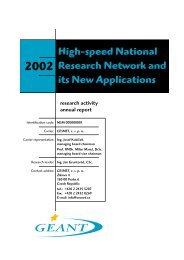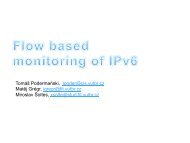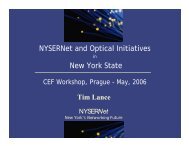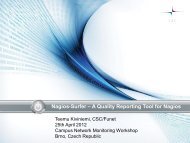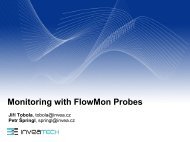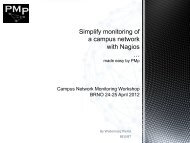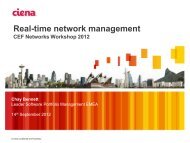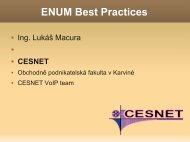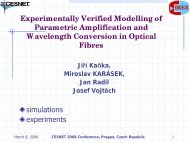Global facilities for Research Networking Using alien wavelengths
Global facilities for Research Networking Using alien wavelengths
Global facilities for Research Networking Using alien wavelengths
Create successful ePaper yourself
Turn your PDF publications into a flip-book with our unique Google optimized e-Paper software.
<strong>Global</strong> <strong>facilities</strong> <strong>for</strong> <strong>Research</strong><strong>Networking</strong> <strong>Using</strong> <strong>alien</strong> <strong>wavelengths</strong>Roeland Nuijts – Optical Network ArchitectCEF 2012 meeting in Prague, September 12-14, 2012
Outline• Introduction• Alien wavelength concept• Alien wavelength advantages and disadvantages• Amsterdam-Hamburg-Copenhagen experiment andproduction• Engineering guidelines <strong>for</strong> <strong>alien</strong> <strong>wavelengths</strong> on theSURFnet7 network using tunable XFPs• Overview of <strong>alien</strong> wavelength demonstrations at SURFnet– Atomic clock transfer Amsterdam-Groningen (320km)– 100G PM-QPSK Amsterdam-Geneva (1650km)– 100G PM-QPSK Amsterdam-Geneva-Amsterdam (3300km)– 40G DC-BPSK Amsterdam-Poznan-Amsterdam (3600km)
SURFnet overview• Approx. 1M end-users from 200 connected institutions• Not-<strong>for</strong>-profit organization, 80 employees• Owned by the Dutch research and education community(universities, research institutes)• Nation-wide hybrid optical and packet switchinginfrastructure• Based on 11000+ km of SURFnet-owned managed darkfiber pair, all the way to the customers premises• Truly collapsed IP backbone (routers at 2 locations only)• Implementing Carrier Ethernet (SURFnet7)
Alien wavelength conceptRxTxTxRx(a) conventional closed DWDM systemRxTxRxTxTxRxTxRx(b) multi-domain DWDM systemsRxTxTxRx(c) multi-domain DWDM systems with <strong>alien</strong> wavelength
AW Advantages• direct connection of customer equipment costsavings• avoid OEO regeneration power savings• faster time to service time savings• support of different modulation <strong>for</strong>mats extend network lifetime
AW Challenges• complex end-to-end optical path engineering interms of linear (i.e. OSNR, dispersion) and nonlinear(FWM, SPM, XPM, Raman) transmissioneffects <strong>for</strong> different modulation <strong>for</strong>mats• complicated system integration/functional testing• end-to-end monitoring, fault isolation andresolution• end-to-end service activation
WSSHamburgWSSWWSSSSExample: Amsterdam-CopenhagenJOINT SURFnet/NORDUnet 40Gb/s PM-QPSK <strong>alien</strong> wavelength DEMONSTRATION40G10GCopenhagenEnd-to-end FoM = 1400(a couple of dB margin over BOL OSNR limit - set against nonlinearities andpotentially adverse effect from filter concatenation [4])416km TWRSAlcatel-Lucent(with dispersion compensation)640km TWRSNortel(without dispersion compensation)Hamburg40G40G10GAmsterdam40G40G <strong>alien</strong> wave900GHz350GHz10G5x10Gb/s10G5x10Gb/s @ 50GHz
AW in production• Engineering guidelines, i.e. guard band, powerlevels being finalized with NORDUnet and TDU(Technical University of Denmark)• Monitoring capabilities– E2Emon approach– Nagios at NORDUnet side– Nagios within Zenoss at SURFnet side– Scheduled to be done end of November, 2012
SURFnet IP traffic growth100Tb/s0.9 dB/year9 years23 %/year2.2 dB/year12 years68 %/yearWDM products0.8 dB/year25 years20 %/year10Tb/sSerial interface speed1Tb/s100Gb/s10Gb/s4.1 dB/year4.5 years159 %/year1.6 dB/year4.0 years46 %/year0.1 dB/year2.0 years3 %/year1.1 dB/year21 months30 %/year1Gb/s
AW in SURFnet7• SURFnet7: IP and LP nodes in each PoP were replacedwith a CE solution, DWDM layer remained (2010)• Tunable XFPs attractive as 10Gb/s DWDM interfacesdue to small size, low power consumption and low cost• Engineering rules <strong>for</strong> implementation? What distancecan these bridge, when connected to the DWDMsystem? Do we need XFP with FEC ($$$) or not?
Amplifier noise in transmission systemsNF = 7.0dB120km(33dB)NF = 4.5dB120km(33dB)120km(33dB)NF = 4.5dB NF = 4.5dB NF = 4.5dB NF = 4.5dB NF = 4.5dBTxOA OA DCF OAOADCFOAOADCFOAFRxBe<strong>for</strong>e transmissionAfter transmission
Power (dBm)(D)OSNR – Delivered Optical Signal toNoise RatioOptical spectrum at output of transmit OA in Amsterdam1(Agilent-OSA, RB=0.5nm)-20-25-30-35-40-45OSNR-50-55-60-65-701526 1530 1534 1538 1542 1546 1550 1554 1558 1562 1566Wavelength (nm)
ROSNR (Required OSNR)
Key design questions1. What is the Delivered OSNR at the output ofa system (i.e. input of the receiver)?2. What is the Required OSNR at the output ofa system?
OSNR (dB, 0.1nm)OSNR calculationNF = 7.0dB120km(33dB)NF = 4.5dB120km(33dB)120km(33dB)NF = 4.5dB NF = 4.5dB NF = 4.5dB NF = 4.5dB NF = 4.5dBTxOAOADCFOAOADCFOAOADCFOAFRxAB C D E F G+12.5dBm/ch0.0dBm/ch+12.5dBm/ch0.0dBm/ch +12.5dBm/ch 0.0dBm/chOSNR calc-4.0dBm/ch-20.5dBm/ch-20.5dBm/ch-20.5dBm/ch50A4540MNS = 2hυB o N sp ,jj =1P j ,in3530BCDEFCalculatedMeasured25G2000 100 200 300 400Length (km)
Comparison measured calculated OSNR‣ Ehv was corrected to Aac value (26.2dB)‣ Best case OSNR <strong>for</strong> all sites displayed‣ Hvs, Ut and Zl below expected‣ Dt1, Gn1 and Nm1 show excellent agreement‣ OSNR Dgl1 too high, possibly power per channel too high/higher than target at Tx output‣ Will be re-measured after installation of CMD44s
Can this expression be simplified?• Power per channel: more or less fixed• Noise figure per amplifier: more or less fixedMNS = 2hυB o N sp ,jj =1P j ,infixed power per channelfixed noise figureNFOM = 10j =1For example: <strong>for</strong> a single span loss of 80km (20dB) the FOM is equal to 100.For a system that can support 10 spans of 80km, the FOM should be below 1000L j10
Measured Required OSNR aftertransmission‣ λ = 1531.51nm, 1548.11nm and 1556.96nm‣ Dispersion is between +1500 and +2000 ps/nm(source: Optical Modeler)‣ Near-optimum decision threshold setting = 50%(default XFP setting)‣ Worst case ROSNR = 22.6dB @ BER=10 -12 , aftertransmission through ring 1
FOM specification-6Back-to-back360km configuration• P rec =-19dBm• After transmission• λ = 1556.96nm (G7C8)• worst case of 17 Tx/Rx combinations-7-8BOL, +1500 < D < +2000ps/nm(test results)Log (BER-Floor)-9-10-11-12-13-14-15+18 +19 +20 +21 +22 +23 +24 +25 +2620 21 22 23 24 25 26 27 28Signal-to-Noise-Ratio (dB)Figure 23: BER-floor as a function of optical SNRROSNR = 22.6dB
FOM specification – cont’d-6Back-to-back360km configuration• P rec =-19dBm• After transmissionLog (BER-Floor)-7-8-9-10-11-12-13-14-15+18 +19 +20 +21 +22 +23 +24 +25 +2620 21 22 23 24 25 26 27 28Signal-to-Noise-Ratio (dB)BOL, +1500 < D < +2000ps/nm(test results)EOL, +1500 < D < +2000ps/nm(1dB margin <strong>for</strong> XFPs)Figure 23: BER-floor as a function of optical SNRROSNR = 23.6dB
FOM specification – cont’d-6Back-to-back360km configuration• P rec =-19dBm• After transmissionLog (BER-Floor)-7-8-9-10-11-12-13-14-15+18 +19 +20 +21 +22 +23 +24 +25 +2620 21 22 23 24 25 26 27 28Signal-to-Noise-Ratio (dB)Figure 23: BER-floor as a function of optical SNRROSNR = 22.3dBROSNR = 23.2dB (BER=10 -15 )BOL, +1500 < D < +2000ps/nm(test results)EOL, +1500 < D < +2000ps/nm(supplier 1dB margin <strong>for</strong> XFPs)EOL, -150 < D < +1100ps/nm(dispersion of NGE links & supplier data)‣ Measured ROSNR at a BER of 10 -15 is equal to 23.2dB (0.1nm res. BW) at EOL and -150
Wavelength planCPL CPL CPL CPL CPL CPL CPL CPL WSS-CPL CPLAmsterdam1 Delft Rotterdam1 Dordrecht1 Breda1 Tilburg1 Eindhoven1 DenBosch1 Utrecht1 Amsterdam2sn2 b1 ch1 Asd001A_OME11 Rt001A_OME01 Asd002A_OME11NGE-79 112 NGE-79/66 NGE-66/84 184 NGE-84sn2 b1 ch2 Rt001A_OME01 Asd002A_OME12NGE-80 112 NGE-80/67 NGE-67/85 184 NGE-85sn2 b1 ch3 Asd001A_O5M02 Rt001A_O5M01 Asd002A_O5M02NGE-82107NGE-82NGE-81 112 NGE-81/17 NGE-17/18 65 NGE-18sn2 b1 ch4sn2 b2 ch1sn2 b2 ch2sn2 b2 ch3sn2 b2 ch4sn2 b3 ch1 Asd001A_OME12 Tb001A_OME01 Asd002A_OME12sn2 b3 ch2 NGE-94 215NGE-94sn2 b3 ch3 Asd001A_O5M02 Tb001A_O5M01 Asd002A_O5M02sn2 b3 ch4sn2 b4 ch1 NGE-74 82 NGE-74/51 133 NGE-51b4 ch2 Asd001A_OME21 Ehv001A_OME03 Asd002A_OME12sn2 b4 ch3 Asd001A_OME12 Ehv001A_OME03 Asd002A_OME12b4 ch4 Asd001A_OME21 Ehv001A_OME03 Asd002A_OME12sn2 b4 ch5 NGE-76 82 NGE-76/52 133 NGE-52b4 ch6 NGE-97 381NGE-97/53 133 NGE-53/108 228 -< to ring 4sn2 b4 ch7 NGE-109 228 -< to ring 4b4 ch8 NGE-107 198NGE-107sn2 b5 ch1 Ut001A sn2 b7sn2 b7 Asd001A_OME23 Aac001A_OME01->sn2 b7 Asd001A_OME23 Aac001A_OME01->sn2 b7Asd002A_OME12sn2 b7sn2 b7sn2 b7
AW Time transfer via SURFnetFrequencycombFrequencycomb• Link part of SURFnet DWDM network• Length 317 km, round trip 635 km• Single l-channel (1559.79 nm)• Fiber carrying live data traffic• WR experiment next
Amsterdam-CERN DWDM system‣ FOM = 1740 (equivalent of 17 x 20dB) (competitor’s FOMs were 2000and 2500)‣ Total distance 1650km, 23 spans‣ No Raman amplification‣ Mix of TW+ (Asd-Paris) and TWRS (Paris-Geneva) fiber‣ No optical dispersion compensation‣ ROADMs in Brussels (BELNET) and Paris‣ High-capacity connection (up to 880Gb/s) between the LHC (LargeHadron Collider) at CERN, Geneva, and SURFnet in the Netherlands‣ Currently two 40Gb/s PM-QPSK channels installed‣ OSNR margin was measured and is sufficient to guarantee 100Gb/sdual carrier PM-QPSK and 100Gb/s single carrier PM-QPSK transmissionbetween Amsterdam and Geneva
AW experiments Amsterdam-CERN• Two 100Gb/s PM-QPSK experiments– CISCO – 1650km – September 2011– Oclaro (Opnext) – 3300km – July 2012• These results emphasize the large tolerance ofPM-QPSK technology against a variety ofimpairments such as CD, PMD and noise andunderlines its feasibility <strong>for</strong> AW services
AW experiments Amsterdam-CERN• Two 100Gb/s PM-QPSK experiments– CISCO – 1650km – September 2011– Oclaro (Opnext) – 3300km – July 2012• These results emphasize the large tolerance ofPM-QPSK technology against a variety ofimpairments such as CD, PMD and noise andunderlines its feasibility <strong>for</strong> AW services
Upcoming• Amsterdam-Poznan-Amsterdam – 3600kmtested with ULH 40Gb/s solution• Further demo during the SURFnet customerevent on October 3 rd and 4th – stay tuned
Conclusion• AW are an efficient approach to building costeffectiveinternational connections betweenNRENS• Developed engineering rules <strong>for</strong> tunable XFPson a DWDM network by using a straight<strong>for</strong>wardeasy-to-use <strong>for</strong>mula• PM-QPSK is very powerful technology <strong>for</strong> <strong>alien</strong><strong>wavelengths</strong> due to its tolerance to a variety ofimpairments (CD, PMD, noise)
Roeland.nuijts@surfnet.nlWwww.surfnet.nl+31 30 2305 305



